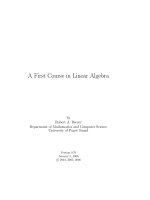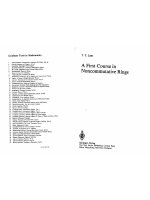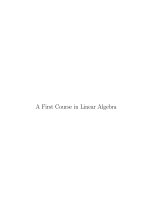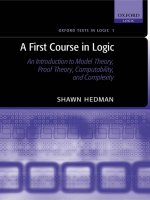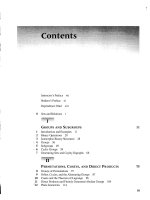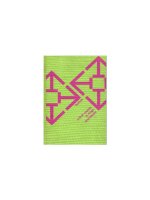A first course in integral equations
Bạn đang xem bản rút gọn của tài liệu. Xem và tải ngay bản đầy đủ của tài liệu tại đây (12.28 MB, 330 trang )
Second Edition
A FIRST COURSE IN INTEGRAL
EQUATIONS
www.pdfgrip.com
A FIRST COURSE IN INTEGRAL
EQUATIONS
Abdul-Majid Wazwaz
Saint Xavier University, USA
www.pdfgrip.com
Published by
World Scientific Publishing Co. Pte. Ltd.
5 Toh Tuck Link, Singapore 596224
USA office: 27 Warren Street, Suite 401-402, Hackensack, NJ 07601
UK office: 57 Shelton Street, Covent Garden, London WC2H 9HE
Library of Congress Cataloging-in-Publication Data
Wazwaz, Abdul-Majid.
A first course in integral equations / by Abdul-Majid Wazwaz (Saint Xavier University, USA). -- Second edition.
pages cm
Includes bibliographical references and index.
ISBN 978-9814675116 (hardcover : alk. paper) -- ISBN 978-9814675123 (pbk.: alk. paper)
1. Integral equations. I. Title.
QA431.W36 2015
515′.45--dc23
2015008111
British Library Cataloguing-in-Publication Data
A catalogue record for this book is available from the British Library.
Copyright © 2015 by World Scientific Publishing Co. Pte. Ltd.
All rights reserved. This book, or parts thereof, may not be reproduced in any form or by any means,
electronic or mechanical, including photocopying, recording or any information storage and retrieval system
now known or to be invented, without written permission from the publisher.
For photocopying of material in this volume, please pay a copying fee through the Copyright Clearance Center, Inc.,
222 Rosewood Drive, Danvers, MA 01923, USA. In this case permission to photocopy is not required from the
publisher.
Printed in Singapore
www.pdfgrip.com
THIS BOOK IS DEDICATED TO
My wife, our son, and our three daughters
for supporting me in all my endeavors
www.pdfgrip.com
Contents
Preface to the Second Edition
Preface to the First Edition
1
Introductory Concepts
1.1 Definitions
1.2 Classification of Linear Integral Equations
1.2.1 Fredholm Linear Integral Equations
1.2.2 Volterra Linear Integral Equations
1.2.3 Integro-Differential Equations
1.2.4 Singular Integral Equations
1.2.5 Volterra-Fredholm Integral Equations
1.2.6 Volterra-Fredholm Integro-Differential Equations
1.3 Solution of an Integral Equation
1.4 Converting Volterra Equation to an ODE
1.4.1 Differentiating Any Integral: Leibniz Rule
1.5 Converting IVP to Volterra Equation
1.6 Converting BVP to Fredholm Equation
1.7 Taylor Series
1.8 Infinite Geometric Series
2
Fredholm Integral Equations
2.1 Introduction
2.2 The Adomian Decomposition Method
2.2.1 The Modified Decomposition Method
2.2.2 The Noise Terms Phenomenon
2.3 The Variational Iteration Method
2.4 The Direct Computation Method
2.5 The Successive Approximations Method
2.6 The Method of Successive Substitutions
2.7 Comparison between Alternative Methods
2.8 Homogeneous Fredholm Integral Equations
2.9 Fredholm Integral Equations of the First Kind
2.9.1 The Method of Regularization
3
Volterra Integral Equations
3.1 Introduction
www.pdfgrip.com
3.2
3.3
3.4
3.5
3.6
3.7
3.8
3.9
The Adomian Decomposition Method
3.2.1 The Modified Decomposition Method
3.2.2 The Noise Terms Phenomenon
The Variational Iteration Method
The Series Solution Method
Converting Volterra Equation to IVP
Successive Approximations Method
The Method of Successive Substitutions
Comparison between Alternative Methods
Volterra Integral Equations of the First Kind
3.9.1 The Series Solution Method
3.9.2 Conversion of First Kind to Second Kind
4
Fredholm Integro-Differential Equations
4.1 Introduction
4.2 Fredholm Integro-Differential Equations
4.3 The Direct Computation Method
4.4 The Adomian Decomposition Method
4.4.1 The Modified Decomposition Method
4.4.2 The Noise Terms Phenomenon
4.5 The Variational Iteration Method
4.6 Converting to Fredholm Integral Equations
5
Volterra Integro-Differential Equations
5.1 Introduction
5.2 Volterra Integro-Differential Equations
5.3 The Series Solution Method
5.4 The Adomian Decomposition Method
5.5 The Variational Iteration Method
5.6 Converting to Volterra Integral Equation
5.7 Converting to Initial Value Problems
5.8 Volterra Integro-Differential Equations of the First Kind
6
Singular Integral Equations
6.1 Introduction
6.2 Abel’s Problem
6.3 The Generalized Abel’s Integral Equation
6.4 The Weakly-Singular Volterra Integral Equations
6.4.1 The Adomian Decomposition Method
6.5 The Weakly-Singular Fredholm Integral Equations
www.pdfgrip.com
6.5.1
The Modified Decomposition Method
7
Nonlinear Fredholm Integral Equations
7.1 Introduction
7.2 Nonlinear Fredholm Integral Equations of the Second Kind
7.2.1 The Direct Computation Method
7.2.2 The Adomian Decomposition Method
7.2.3 The Variational Iteration Method
7.3 Nonlinear Fredholm Integral Equations of the First Kind
7.3.1 The Method of Regularization
7.4 Nonlinear Weakly-Singular Fredholm Integral Equations
7.4.1 The Modified Decomposition Method
8
Nonlinear Volterra Integral Equations
8.1 Introduction
8.2 Nonlinear Volterra Integral Equations of the Second Kind
8.2.1 The Series Solution Method
8.2.2 The Adomian Decomposition Method
8.2.3 The Variational Iteration Method
8.3 Nonlinear Volterra Integral Equations of the First Kind
8.3.1 The Series Solution Method
8.3.2 Conversion to a Volterra Equation of the Second Kind
8.4 Nonlinear Weakly-Singular Volterra Integral Equations
8.4.1 The Modified Decomposition Method
9
Applications of Integral Equations
9.1 Introduction
9.2 Volterra Integral Form of the Lane-Emden Equation
9.2.1 Lane-Emden Equation of the First Kind
9.2.2 Lane-Emden Equation of the Second Kind
9.3 The Schlömilch’s Integral Equation
9.3.1 The Linear Schlömilch’s Integral Equation
9.3.2 The Method of Regularization
9.3.3 The Nonlinear Schlömilch’s Integral Equation
9.4 Bratu-Type Problems
9.4.1 First Bratu-Type Problem
9.4.2 Second Bratu-Type Problem
9.4.3 Third Bratu-Type Problem
9.5 Systems of Integral Equations
9.5.1 Systems of Fredholm Integral Equations
www.pdfgrip.com
9.6
9.7
9.5.2 Systems of Volterra Integral Equations
Numerical Treatment of Fredholm Integral Equations
Numerical Treatment of Volterra Integral Equations
A Table of Indefinite Integrals
B Integrals Involving Irrational Algebraic Functions
C Series
D The Error and the Gamma Functions
Answers to Exercises
Bibliography
Index
www.pdfgrip.com
Preface to the Second Edition
Within the last eighteen years since the publication of the first edition of A First Course
in Integral Equations, the growth in the field of Integral Equations has been flourishing
with many advances. The new developments, which complement the traditional
concepts, present clear expositions of the main concepts and keys of Integral Equations.
Moreover, a further significant recognition of the use of Integral Equations in scientific
fields, engineering, and mathematics has developed. This recognition has been followed
up with further achievements in research. Like the first edition, the second edition is
helpful to a wide range of advanced undergraduate and graduate students in varying
fields, as well as researchers in science, mathematics, and engineering. Some of the
strengths of the new edition are the detailed treatments, clarifications, explanations of
the new developments, discussions of the wide variety of examples, and the wellpresented illustrations to aid the learner to better understand the concepts.
In editing this new edition, the following distinguishing features, above the
pedagogical aims of the first edition, were highly considered:
1. Many new and remarkable developments have been added. The scope of each chapter
is extended to contain these fascinating new findings.
2. The linear and the nonlinear integral equations were handled in a systematic manner
with more methods and applications. This edition provides very systematic and detailed
instructions on how to handle each kind of equations.
3. Many people have written to me since the publication of the first edition. They
offered many useful and constructive suggestions. Their suggestions for extending some
topics were honored in this text.
4. The fruitful evaluations, made by my students who used the first edition, provide
useful input. My students’ questions and concerns were addressed in this edition.
5. A new application chapter has been added to discuss a variety of scientific
applications. Numerical and analytic treatments of linear and nonlinear integral
equations are explained in this chapter to highlight the effectiveness of the traditional
and the new methods.
6. The exact solutions of integral equations play a significant role in the proper
understanding of the features and structures of the problem. For this reason, and based
upon a vast request by readers, a solutions manual has been made that gives detailed
explanations and illustrations for solving each problem of the second edition.
I would like to acknowledge the encouragement of my wife who supported me in all
my endeavors, and in this edition and the accompanied solutions manual. I would also
like to acknowledge our son and three daughters for their support and encouragement.
www.pdfgrip.com
Saint Xavier University
Chicago, IL 60655
Summer 2015
Abdul-Majid Wazwaz
e-mail:
www.pdfgrip.com
Preface to the First Edition
Engineering, physics and mathematics students, both advanced undergraduate and
beginning graduate, need an integral equations textbook that simply and easily
introduces the material. They also need a textbook that embarks upon their already
acquired knowledge of regular integral calculus and ordinary differential equations.
Because of these needs, this textbook was created. From many years of teaching, I have
found that the available treatments of the subject are abstract. Moreover, most of them
are based on comprehensive theories such as topological methods of functional
analysis, Lebesgue integrals and Green functions. Such methods of introduction are not
easily accessible to those who have not yet had a background in advanced mathematical
concepts. This book is especially designed for those who wish to understand integral
equations without having the extensive mathematical background. In this fashion, this
text leaves out abstract methods, comprehensive methods and advanced mathematical
topics.
From my experience in teaching and in guiding related senior seminar projects for
advanced undergraduate students, I have found that the material can indeed be taught in
an accessible manner. Students have showed both a lot of motivation and capability to
grasp the subject once the abstract theories and difficult theorems were omitted. In my
approach to teaching integral equations, I focus on easily applicable techniques and I do
not emphasize such abstract methods as existence, uniqueness, convergence and Green
functions. I have translated my means of introducing and fully teaching this subject into
this text so that the intended user can take full advantage of the easily presented and
explained material.
I have also introduced and made full use of some recent developments in this field.
The book consists of six chapters, each being divided into sections. In each chapter
the equations are numbered consecutively and distinctly from other chapters. Several
examples are introduced in each section, and a large number of exercises are included
to give the students a constructive insight through the material and to provide them with
useful practice.
In this text, we were mainly concerned with linear integral equations, mostly of the
second kind. The first chapter introduces classifictions of integral equations and
necessary techniques to convert differential equations to integral equations or vice
versa. The second chapter deals with linear Fredholm integral equations and the
reliable techniques, supported by the new developments, to handle this style of
equations. The linear Volterra integral equations are handled, using the recent
developed techniques besides standard ones, in Chapter 3. The topic of integrodifferential equations has been handled in Chapter 4 and reliable techniques were
www.pdfgrip.com
implemented to handle the essential link between differential and integral operators.
The fifth chapter introduces the treatment of the singular and the weakly singular
Volterra type integral equations. The sixth chapter deals with the nonlinear integral
equations. This topic is difficult to study. However, recent schemes have been
developed which show improvements over existing techniques and allow this topic to
be far more easily accessible for specific cases. A large number of nonlinear integral
examples and exercises are investigated.
Throughout the text, examples are provided to clearly and throughly introduce the
new material in a clear and absorbable fashion. Many exercises are provided to give
the new learner a chance to build his confidence and ease with the newly learned
material. The exercises increase in complexity, to challenge the student.
Finally, the text has three useful Appendices. These Appendices provide the user
with the integral forms, Maclaurin series and other related materials which are needed
to be used in the exercises.
The author would highly appreciate any note concerning any error found.
Chicago, IL 1995
Abdul-Majid Wazwaz
www.pdfgrip.com
Chapter 1
Introductory Concepts
1.1
Definitions
An integral equation is an equation in which the unknown function u(x) to be determined
appears under the integral sign. A typical form of an integral equation in u(x) is of the
form
where K(x, t) is called the kernel of the integral equation, and α(x) and β(x) are the
limits of integration. In (1), it is easily observed that the unknown function u(x) appears
under the integral sign as stated above, and out of the integral sign in most other cases as
will be discussed later. It is important to point out that the kernel K(x, t) and the function
f(x) in (1) are given in advance. Our goal is to determine u(x) that will satisfy (1), and
this may be achieved by using different techniques that will be discussed in the
forthcoming chapters. The primary concern of this text will be focused on introducing
these methods and techniques supported by illustrative and practical examples.
Integral equations arise naturally in physics, chemistry, biology and engineering
applications modelled by initial value problems for a finite interval [a, b]. More details
about the sources and origins of integral equations can be found in [12] and [14]. In the
following example we will discuss how an initial value problem will be converted to
the form of an integral equation.
Example 1. Consider the initial value problem
subject to the initial condition
The equation (2) can be easily solved by using the method of separation of variables;
where by using the initial condition (3), the solution
www.pdfgrip.com
is easily obtained. However, integrating both sides of (2) with respect to x from 0 to x
and using the initial condition, Eq. (3) yields the following
or equivalently
obtained by integrating the left hand side of (5) and by using the given initial condition
(3). Comparing (6) with (1) we find that f(x) = 1 and the kernel K(x, t) = 2t.
We will further discuss the algorithms of converting initial value problems and
boundary value problems in detail to equivalent integral equations in the forthcoming
sections. As stated above, our task is to determine the unknown function u(x) that
appears under the integral sign as in (1) and (6) and that will satisfy the given integral
equation.
We further point out that integral equations as ( 1) and (6) are called linear integral
equations. This classification is used if the unknown function u(x) under the integral sign
occurs linearly i.e. to the first power. However, if u(x) under the integral sign is
replaced by a nonlinear function in u(x), such as u2(x), cos u(x), cosh u(x) and eu(x),
etc., the integral equation is called in this case a nonlinear integral equation.
1.2
Classification of Linear Integral Equations
The most frequently used linear integral equations fall under two main classes namely
Fredholm and Volterra integral equations. However, in this text we will distinguish four
more related types of linear integral equations in addition to the two main classes. In
what follows, we will give a list of the Fredholm and Volterra integral equations, and
the four related types:
1. Fredholm integral equations
2. Volterra integral equations
3. Integro-differential equations
4. Singular integral equations
5. Volterra-Fredholm integral equations
6. Volterra-Fredholm integro-differential equations
In the following we will outline the basic definitions and properties of each type.
www.pdfgrip.com
1.2.1 Fredholm Linear Integral Equations
The standard form of Fredholm linear integral equations, where the limits of integration
a and b are constants, are given by the form
where the kernel of the integral equation K(x, t) and the function f(x) are given in
advance, and λ is a parameter. The equation (7) is called linear because the unknown
function u(x) under the integral sign occurs linearly, i.e. the power of u(x) is one.
The value of (x) will give the following kinds of Fredholm linear integral equations:
1. When (x) = 0, Eq. (7) becomes
and the integral equation is called Fredholm integral equation of the first kind.
2. When (x) = 1, Eq. (7) becomes
and the integral equation is called Fredholm integral equation of the second kind.
In fact, the equation (9) can be obtained from (7) by dividing both sides of (7) by
(x) provided that (x) ≠ 0.
In summary, the Fredholm integral equation is of the first kind if the unknown function
u(x) appears only under the integral sign. However, the Fredholm integral equation is of
the second kind if the unknown function u(x) appears inside and outside the integral
sign.
1.2.2 Volterra Linear Integral Equations
The standard form of Volterra linear integral equations, where the limits of integration
are functions of x rather than constants, are of the form
where the unknown function u(x) under the integral sign occurs linearly as stated before.
www.pdfgrip.com
It is worth noting that (10) can be viewed as a special case of Fredholm integral
equation when the kernel K(x, t) vanishes for t > x, x is in the range of integration [a, b].
As in Fredholm equations, Volterra integral equations fall under two kinds,
depending on the value of (x), namely:
1. When (x) = 0, Eq. (10) becomes
and in this case the integral equation is called Volterra integral equation of the first
kind.
2. When (x) = 1, Eq. (10) becomes
and in this case the integral equation is called Volterra integral equation of the
second kind.
Examining the equations (7)–(12) carefully, the following remarks can be concluded:
In summary, the Volterra integral equation is of the first kind if the unknown function
u(x) appears only under the integral sign. However, the Volterra integral equation is of
the second kind if the unknown function u(x) appears inside and outside the integral
sign.
Remarks
Examining the equations (7)–(12) carefully, the following remarks can be concluded.
1. The structure of Fredholm and Volterra equations:
The unknown function u(x) appears linearly only under the integral sign in linear
Fredholm and Volterra integral equations of the first kind. However, the unknown
function u(x) appears linearly inside the integral sign and outside the integral sign
as well in the second kind of both linear Fredholm and Volterra integral equations.
2. The limits of integration:
In Fredholm integral equations, the integral is taken over a finite interval with fixed
limits of integration. However, in Volterra integral equations, at least one limit of
the range of integration is a variable, and the upper limit is the most commonly
used with a variable limit.
www.pdfgrip.com
3. The origins of integral equations:
It is important to note that integral equations arise in engineering, physics,
chemistry, and biology problems [12] and [14]. Further, integral equations arise as
representation forms of differential equations. Furthermore, Fredholm and Volterra
integral equations arise from different origins and applications, such as boundary
value problems as in Fredholm equations, and from initial value problems as in
Volterra equations. Based on the fact that integral equations arise from distinct
origins, different techniques and approaches will be used to determine the solution
of each type of integral equations.
4. The linearity property:
As indicated before, the unknown function u(x) in Fredholm and Volterra integral
equations (9) and (12) occurs to the first power wherever it exists. However,
nonlinear Fredholm and Volterra integral equations arise if u(x) is replaced by a
nonlinear function F(u(x)), such as u2(x), u3(x), eu(x) and so on. The following are
examples of nonlinear integral equations:
where the linear function u(x) in (1) has been replaced by the nonlinear functions
u2(t), eu(t) and sin(u(t)) respectively.
5. The homogeneity property:
If we set f(x) = 0 in Fredholm or Volterra integral equation of the second kind
given by (9) and (12), the resulting equation is called a homogeneous integral
equation, otherwise it is called nonhomogeneous or inhomogeneous integral
equation.
6. The singular behavior of the integral equation:
An integral equation is called singular if the integration is improper. This usually
occurs if the interval of integration is infinite, or if the kernel becomes unbounded
at one or more points of the interval of consideration a ≤ t ≤ b. Singular integral
equations will be defined later. However, the methods to handle singular integral
www.pdfgrip.com
equations will be introduced in Chapter 6.
It is worth noting that four other types of integral equations, related to the two main
classes Fredholm and Volterra integral equations arise in many science and engineering
applications. In the following, we introduce these significant equations as distinct types.
1.2.3 Integro-Differential Equations
Volterra, in the early 1900, studied the population growth, where new type of equations
have been developed and was termed as integro-differential equations. In this type of
equations, the unknown function u(x) occurs in one side as an ordinary derivative, and
appears on the other side under the integral sign. Several phenomena in physics and
biology [14] and [20] give rise to this type of integro-differential equations. Further, we
point out that an integro-differential equation can be easily observed as an intermediate
stage when we convert a differential equation to an integral equation as will be
discussed later in the coming sections.
The following are examples of integro-differential equations:
Equations (16)–(17) are Volterra integro-differential equations, and (18) is a
Fredholm integro-differential equation. This classification has been concluded as a
result to the limits of integration. The solution for integrodifferential equations will be
established using in particular the most recent developed techniques. The integrodifferential equations will be discussed extensively in Chapters 4 and 5.
1.2.4 Singular Integral Equations
The integral equation of the first kind
or the integral equation of the second kind
www.pdfgrip.com
is called singular if the lower limit, the upper limit or both limits of integration are
infinite. In addition, the equation (19) or (20) is also called a singular integral equation
if the kernel K(x, t) becomes infinite at one or more points in the domain of integration.
Examples of the first type of singular integral equations are given by the following
examples:
where the singular behavior in these examples has resulted from the range of integration
becoming infinite.
Examples of the second kind of singular integral equations are given by
where the singular behavior in this kind of equations has resulted from the kernel K(x, t)
becoming infinite as t → x.
It is important to note that integral equations similar to examples (24) and (25) are
called Abel’s integral equation and generalized Abel’s integral equation respectively.
Moreover these types of singular integral equations are among the earliest integral
equations established by the Norwegian mathematician Niels Abel in 1823. Singular
equations similar to example (26) are called the weakly-singular second-kind Volterra
type integral equations. This type of equations usually arises in science and engineering
applications like heat conduction, super-fluidity and crystal growth. The singular
integral equations and the methods to handle it will be discussed in Chapter 6.
1.2.5 Volterra-Fredholm Integral Equations
www.pdfgrip.com
The Volterra-Fredholm integral equation, which is a combination of disjoint Volterra
and Fredholm integrals, appears in one integral equation. The Volterra-Fredholm
integral equations arise from the modelling of the spatiotemporal development of an
epidemic, from boundary value problems and from many physical and chemical
applications. The standard form of the Volterra-Fredholm integral equation reads
where K1(x, t) and K2(x, t) are the kernels of the equation.
Examples of the Volterra-Fredholm integral equations are
and
Notice that the unknown function u(x) appears inside the Volterra and Fredholm
integrals and outside both integrals.
1.2.6 Volterra-Fredholm Integro-Differential Equations
The Volterra-Fredholm integro-differential equation, which is a combination of disjoint
Volterra and Fredholm integrals and differential operator, may appear in one integral
equation. The Volterra-Fredholm integro-differential equations arise from many
physical and chemical applications similar to the Volterra-Fredholm integral equations.
The standard form of the Volterra-Fredholm integro-differential equation reads
where K1(x, t) and K2(x, t) are the kernels of the equation, and is the order of the
ordinary derivative of u(x). Notice that because this kind of equations contain ordinary
derivatives, then initial conditions should be prescribed depending on the order of the
derivative involved.
Examples of the Volterra-Fredholm integro-differential equations are
www.pdfgrip.com
and
Notice that the unknown function u(x) appears inside the Volterra and Fredholm
integrals and outside both integrals.
In closing this section, we illustrate the classifications and the basic concepts that
were discussed earlier by the following examples.
Example 1. Classify the following integral equation
as Fredholm or Volterra integral equation, linear or nonlinear and homogeneous or
nonhomogeneous.
Note that the upper limit of the integral is x and the function u(x) appears twice. This
indicates that the equation (33) is a Volterra integral equation of the second kind. The
equation (33) is linear since the unknown function u(t) appears linearly inside and
outside the integral sign. The presence of the function
classifies the
equation as a nonhomogeneous equation.
Example 2. Classify the following integral equation
as Fredholm or Volterra integral equation, linear or nonlinear and homogeneous or
nonhomogeneous.
The limits of integration are constants and the function u(x) appears twice, therefore
the equation (34) is a Fredholm integral equation of the second kind. Further, the
unknown function appears under the integral sign with power two indicating the
equation is a nonlinear equation. The nonhomogeneous part f(x) appears in the equation
showing that it is a nonhomogeneous equation.
Example 3. Classify the following equation
as Fredholm or Volterra integro-differential equation, and linear or nonlinear.
www.pdfgrip.com
It is easily seen that (35) includes differential and integral operators, and by noting
that the upper limit of the integral is a variable, we conclude that (35) is a Volterra
integro-differential equation. Moreover, the equation is linear since u(x) and u′(x)
appear linearly in the equation.
We finally discuss the following example.
Example 4. Discuss the type, linearity and homogeneity of the following equation
This equation combines Volterra and Fredholm integrals, hence it is Volterra–Fredholm
integral equation. It is nonlinear because of the term sin(u(t)). It is nonhomogeneous
because f(x) = 1.
We point out that linear Fredholm integral equations, linear Volterra integral
equations, integro-differential equations, singular integral equations, Volterra-Fredholm
integral and integro-differential equations will be discussed in the forthcoming chapters.
The Volterra and Fredholm nonlinear integral equations will also be briefly discussed.
The recent developed methods, that proved its effectiveness and reliability, will be
applied to all types of integral equations. In other words, we will use the Adomian
decomposition method (ADM) and the variational method (VIM) for handling these
chapters. Some of the traditional methods will also be used so that newly developed
methods and traditional methods complement each other.
Exercises 1.2
I n exercises 1-10, classify each of the following integral equations as Fredholm or
Volterra integral equation, linear or nonlinear, and homogeneous or nonhomogeneous:
(1)
(2)
(3)
(4)
(5)
(6)
(7)
www.pdfgrip.com
(8)
(9)
(10)
I n exercises 11–15, classify the following integro-differential equations as Fredholm
integro-differential equation or Volterra integro-differential equation. Also determine
whether the equation is linear or nonlinear:
(11)
(12)
(13)
(14)
(15)
u(0) = 1
,
u(0) = 0
,
u(0) = 1, u′(0) = 0
,
u(0) = 1, u′(0) = 0, u″(0) = −1
,
,
u(0) = u′(0) = 0, u″(0) = 2
In exercises 16–20, integrate both sides of each of the following differential equations
once from 0 to x, and use the given initial condition to convert to a corresponding
integral equation or integro-differential equation. (Follow Example 1.)
(16) u′(x) = 4u(x), u(0) = 1.
(17) u′(x) = 3x2u(x), u(0) = 1.
(18) u′(x) = u2(x), u(0) = 4.
(19) u″(x) = 4xu2(x), u(0) = 2, u′(0) = 1.
(20) u″(x) = 2xu(x), u(0) = 0, u′(0) = 1.
I n exercises 21–22, discuss the type, linearity and homogeneity of the following
equations
(21)
(22)
(23)
(24)
1.3
, u(0) = 1
, u(0) = 0
Solution of an Integral Equation
www.pdfgrip.com
A solution of an integral equation or an integro-differential equation on the interval of
integration is a function u(x) such that it satisfies the given equation. In other words, if
the given solution is substituted in the right hand side of the equation, the output of this
direct substitution must yield the left hand side, i.e. we should verify that the given
function u(x) satisfies the integral equation or the integro-differential equation under
discussion. This important concept will be illustrated first by examining the following
examples.
Example 1. Show that u(x) = ex is a solution of the Volterra integral equation
Substituting u(x) = ex in the right hand side (RHS) of (37) yields
Example 2. Show that u(x) = x is a solution of the following Fredholm integral equation
Substituting u(x) = x in the right hand side of (39) we obtain
Example 3. Show that u(x) = x is a solution of the following Fredholm integrodifferential equation
Substituting u(x) = x in the right hand side of (41) we obtain
www.pdfgrip.com


